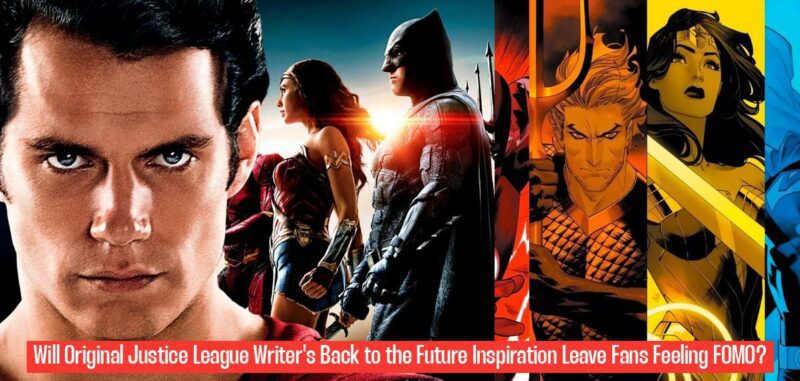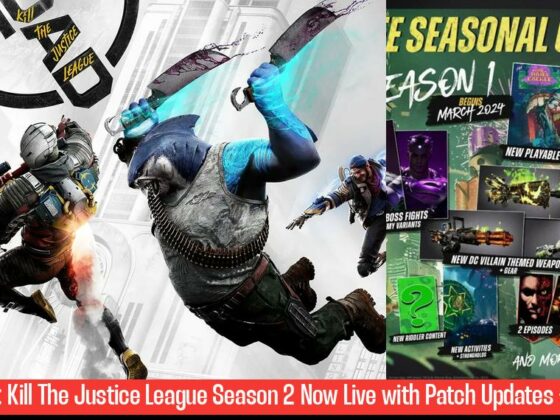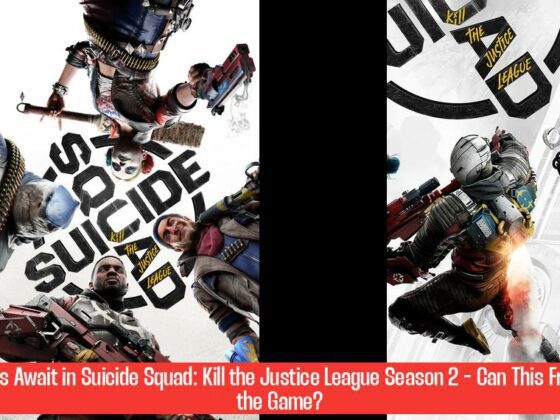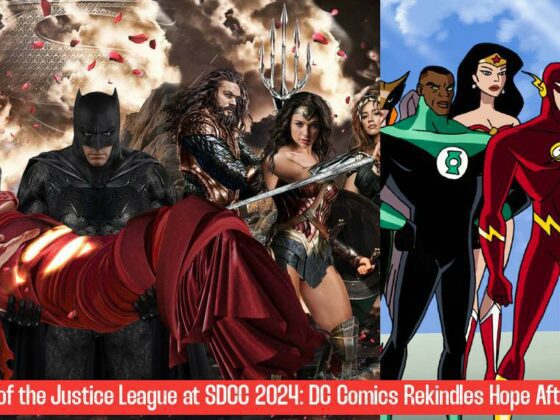Original Justice League Writer’s Back to the Future Influence Sparks FOMO
The DC Universe is a vast and ever-evolving landscape. With the recent announcement of James Gunn and Peter Safran’s ambitious plans for a revamped shared universe, known as “Gods and Monsters,” DC fans are abuzz with anticipation. But amidst the excitement, a nostalgic whisper has emerged, reminding us of what could have been. Original Justice League writer Will Beall recently revealed his vision for the iconic superhero team, drawing a fascinating comparison to the beloved time-traveling classic, Back to the Future. His words have sparked a cascade of “FOMO” (fear of missing out) among fans, leaving us yearning for a glimpse of the Justice League he envisioned.
Beall’s Back to the Future analogy might seem like an unconventional comparison, but it’s actually quite illuminating. The iconic 1985 film, starring the charismatic Michael J. Fox as Marty McFly, chronicles a series of time-traveling misadventures that ultimately lead to a poignant exploration of family, responsibility, and the power of choice. Beall, drawing inspiration from the film’s sequel, Back to the Future Part II, envisioned a Justice League adventure where the heroes find themselves facing a future they’ve inadvertently created. This concept, with its inherent themes of consequence and the potential for reconciliation, resonated with Beall’s vision for the Justice League.
Exploring the “What If” Scenario
Imagine a Justice League movie where the heroes, instead of fighting a singular, catastrophic threat, are confronted with the ramifications of their own actions. The film could delve into the complex consequences of their past decisions, forcing them to confront the unintended consequences of their power. This concept, reminiscent of the moral dilemmas explored in Back to the Future, would have elevated the Justice League story beyond a simple superhero showdown.
Imagine witnessing the Justice League’s internal conflicts as they grapple with the weight of their actions. Would they embrace their role as guardians of the future, or would they struggle to reconcile their heroic ideals with the unforeseen consequences of their choices? This introspective exploration of the heroes’ moral compass, coupled with the dynamic time-traveling element, could have created a truly unique and emotionally resonant cinematic experience.
The Lost Justice League: A Cinematic Missed Opportunity?
While Beall’s Back to the Future-inspired Justice League script was ultimately discarded, the seed of an intriguing idea was planted. The notion of a Justice League saga where the heroes are forced to confront the ripple effects of their actions holds immense potential for dramatic exploration. It could have been a film that transcended the typical superhero genre, delving into the complexities of moral responsibility and the intricate tapestry of cause and effect.
The Back to the Future analogy serves as a powerful reminder of the boundless possibilities that exist within the realm of storytelling, particularly when it comes to superhero narratives. It’s a reminder that even the most established franchises can benefit from a fresh perspective, a willingness to explore uncharted territories, and an unwavering commitment to delivering a compelling narrative.
The Justice League’s Evolving Legacy
The Justice League has undergone numerous iterations throughout its storied history. From the vibrant animation of the Justice League Unlimited series to Zack Snyder’s gritty and complex cinematic interpretations, the team’s legacy has been shaped by a diverse range of creative visions. The original Justice League, consisting of iconic heroes like Superman, Batman, Wonder Woman, Flash, Green Lantern, Martian Manhunter, and Aquaman, has captivated audiences for generations. However, the team’s membership has expanded over time, incorporating new faces and reflecting the changing landscape of comics and popular culture.
The Justice Society, a precursor to the Justice League, was established as existing on “Earth-Two,” while the Justice League resided on “Earth-One” – different versions of Earth in separate universes. This creative concept allowed for annual cross-dimensional team-ups between the two groups from 1963 to 1985. The Justice League’s evolution underscores the franchise’s versatility and its capacity to adapt to evolving storytelling trends.
The Future of the Justice League: A Time for Innovation
The Justice League’s future remains uncertain, but with James Gunn and Peter Safran at the helm, it’s safe to say that the team’s next chapter will be an exciting one. Gunn’s bold and unconventional approach to superhero storytelling, combined with Safran’s extensive experience in the industry, promises a fresh and invigorating take on the Justice League. While we may never get to experience Beall’s Back to the Future-inspired Justice League, the legacy of his vision serves as a reminder of the potential that lies within the franchise.
The DC Universe is in constant flux, and with each new iteration, the Justice League continues to evolve. As fans, we can anticipate a future filled with surprises, twists, and thrilling adventures. The Justice League, with its enduring popularity and its ability to embrace change, is a testament to the enduring power of comic book storytelling.
The “FOMO” Factor: A Reflection on Missed Opportunities
The feeling of “FOMO” that Beall’s revelations have sparked is a testament to the power of storytelling and the enduring allure of the “what if” scenario. It’s a reminder that even within the established narratives of beloved franchises, there’s always room for imagination and the exploration of alternative possibilities.
The “FOMO” factor isn’t simply a fleeting emotion; it’s a reflection of our yearning for creative exploration and our desire to witness stories that push the boundaries of what we think we know. Beall’s Back to the Future-inspired vision serves as a reminder that even within the confines of a well-defined universe, there’s always room for innovation, for the exploration of fresh perspectives, and for the creation of stories that resonate with audiences on a deeper level.
Embracing the “FOMO” for a Brighter Future
While we may never experience Beall’s Justice League, his vision serves as a valuable lesson in embracing the “FOMO” factor. Instead of dwelling on missed opportunities, we can use this feeling as a catalyst for creative exploration and a renewed appreciation for the storytelling possibilities that lie ahead. The DC Universe, with its vast array of characters and stories, is a fertile ground for innovation and a constant source of inspiration.
The “FOMO” we experience isn’t simply a negative emotion. It’s a powerful reminder of our desire for compelling stories, for narratives that push boundaries, and for creative visions that inspire us. As fans, we can embrace this feeling, channel it into our own creative endeavors, and look forward to the exciting stories that the future holds.
The Power of Fan Engagement
Beall’s revelations underscore the importance of fan engagement in the world of comic book adaptations. Fans are not merely passive consumers; they are active participants in the creative process. Their passion, their insights, and their collective voice shape the evolution of beloved franchises.
The “FOMO” that Beall’s story has ignited is a testament to the power of fan engagement. It’s a reminder that fans are invested in these narratives, that they crave stories that resonate with their hopes and dreams, and that they are eager to participate in shaping the future of these franchises.
The Future of Storytelling: Pushing Boundaries
The Justice League is a testament to the enduring power of comic book storytelling. As the franchise evolves, it’s crucial to embrace innovation, to push boundaries, and to tap into the creative potential of the characters and stories that have captivated audiences for generations.
The “FOMO” we experience when we’re reminded of a story that could have been is a valuable reminder of the power of creative exploration. It’s a catalyst for pushing boundaries, for embracing new ideas, and for creating stories that truly resonate with audiences.
The DC Universe is a vast and ever-evolving landscape, brimming with potential. As fans, we can embrace the “FOMO” factor, channel it into our own creative endeavors, and look forward to the exciting stories that the future holds.
What influence did Back to the Future have on the original Justice League writer’s vision?
The original Justice League writer, Will Beall, drew inspiration from Back to the Future for his vision of the iconic superhero team. He envisioned a storyline where the heroes face the consequences of their own actions, similar to the themes explored in the time-traveling classic.
How did Will Beall’s vision for the Justice League spark FOMO among fans?
Will Beall’s comparison of his Justice League vision to Back to the Future sparked FOMO (fear of missing out) among fans, leaving them yearning to see the Justice League story he had envisioned but never came to fruition.
What was the concept behind Will Beall’s Justice League vision?
Will Beall’s vision for the Justice League involved the heroes facing a future they inadvertently created, exploring the consequences of their past decisions and the moral dilemmas that arise when confronted with the unintended outcomes of their actions.
Don’t Miss – Tina Knowles Proudly Celebrates Granddaughter Blue Ivy’s BET Award Win
How would a Justice League movie based on Will Beall’s vision have differed from traditional superhero showdowns?
A Justice League movie based on Will Beall’s vision would have delved into the heroes’ internal conflicts and moral compass as they grapple with the repercussions of their choices. It would have elevated the story beyond a simple superhero showdown by exploring the complexities of their power and the consequences of their actions.



